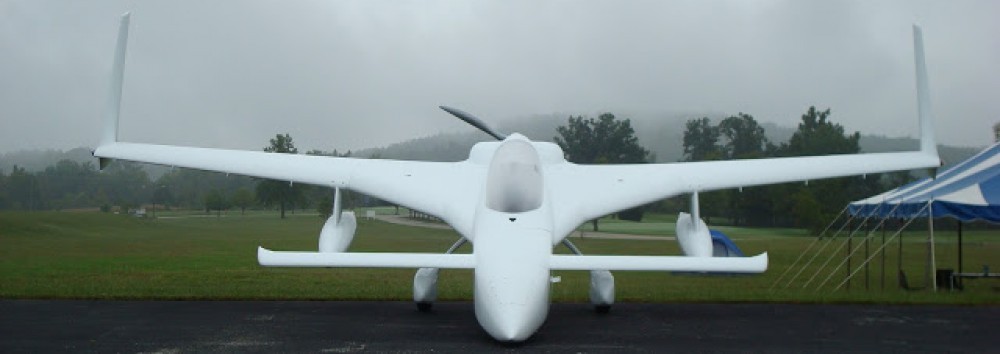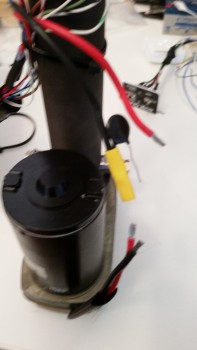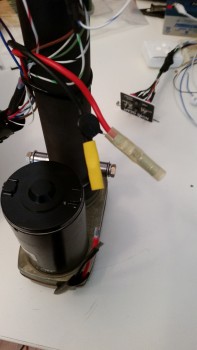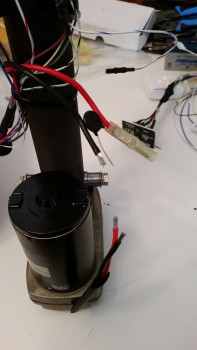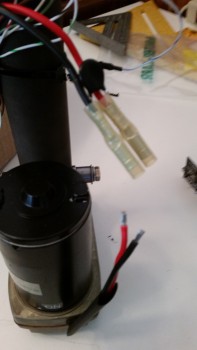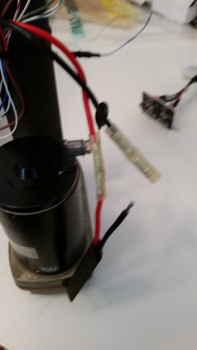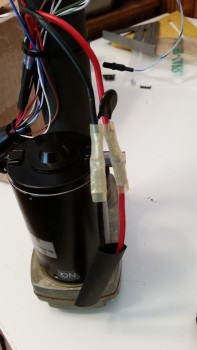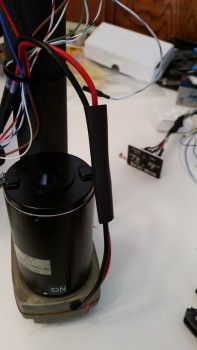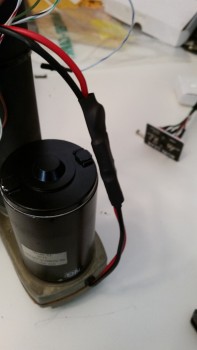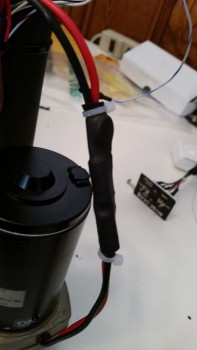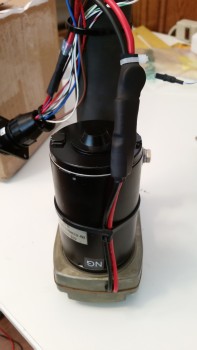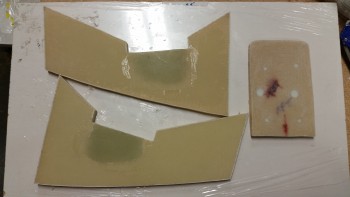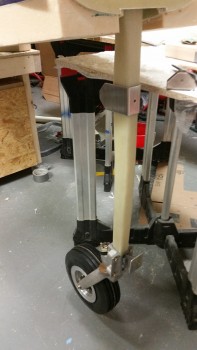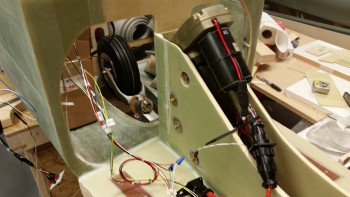Yep, that’s me! Or maybe I should have titled this post, “The Anatomy of a Repair.”
I had committed two grave sins in the wiring of the AEX P2 connector, one on each side. On the switch side I found pin 1, inserted that wire and then started filling in the wires per color from pin 1, first across and then down. The only problem was that my first direction was as it should be if I was looking on the FRONT of the connector face, versus the mirror image it should have been on the back plate of the connector. Ooops. Well, as I said yesterday, I caught that after my discussion with Jack and remedied it.
What I didn’t catch was the wiring mistake I made on the AEX side of the P2 plug. When I had original diagrammed out the connector pins for that side, I realized that I hadn’t made the diagram in the normal top row=1-3, middle row=4-6, bottom row=7-9 pattern. If you took the diagram and flipped it 180° from the upper right corner down to the lower left corner, that is what I ended with: column A= pins 1-3, column B= pins 4-6, column C=pins 7-9. Thus, when I wired it up (mistake #3 actually, since it was LATE at night) I had the mental picture of the initial diagram (left below) in my head, not the correct one (right below).
I got ahold of Jack later in the afternoon to figure out the wiring issue with the electrical nose gear actuator. With the AEX presumably Tango-Uniform, I thought that perhaps I needed another jumper on pin P2 along with pins 5 & 6. I wasn’t sure about the jumper situation due the fact that since I ordered the AEX with my initial order of the gear actuator, I never received a jumper plug.
After some discussion Jack told me that if P2 pins 5 & 6 jumpered wasn’t getting the nose gear actuator to go back up, then I should try a jumper across pins 1 & 4. Ok, I had the plan and was ready to execute. I got off the phone ready to throw a jumper across pins 1 & 4. Uh, the only problem was there was no pin 1. The switch side of the P2 connector has 9 pins, and pins 1 & 2 are empty!
I called Jack back a few minutes later and gave him my report. With that knowledge in hand, along with my trusty Fluke, Jack began to guide me through checking voltage readings from points A → B, X → R, etc. I checked the relays by holding them up to my ear as I flipped the switch and was pleased to hear an audible springy click. We checked the up-travel microswitch since this was the primary culprit: 12.86V on both sides. All good. Then I checked the main power wires going into the actuator motor. 12.86V on the red and .005V on the ground… all good.
We were both stumped and Jack concluded that it appeared that the motor was bad. The problem was that these motors are amazingly robust and have an extremely low failure rate. Jack asked me to locate the heat-shrinked power connectors inches from where they exit the motor housing. I did. He then asked me to give all the wires a good tug to make sure they were connected nice & snug. They weren’t. The wires closest to the motor came out with the slightest pull.
That, my dear friends, seemed to be the real issue.
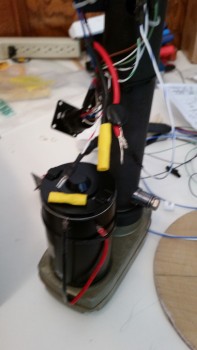
I asked Jack if I could run power straight to the motor with the inline fuse on the power side and he said yes. When I did, I was pleased to have the motor jump to life. Issue found!
(Thanks Jack, for such a great job talking me through the troubleshooting!)
[Note: Some of these pics are blurry since I’m using my phone camera … sorry. I guess phone cameras are made these days primarily for taking selfies to post on FaceBook!]
As you can see in the pic below, the yellow butt splice wire connectors are more automotive grade, which should have done the job ok, but for whatever reason here they didn’t.
Since the butt splice connector on the black wire was firmly in place, I started with replacing the one on the red wire. I was able to pull it off with a firm pull.
I then spliced on a higher grade butt splice connector that came in an electrical connector kit that I bought from B&C. You can tell the difference between the two immediately in the pic below.
With the red wire butt splice in place, I then pulled the old connector off the black wire and crimped a new butt splice connector in its place.
With the switch side completed, it was time to crimp the motor side wires into the butt splice connectors. I had already found an appropriate sized piece of heat shrink and slid it into place before completing the butt splicing.
I crimped the red wire butt splice first, and then finished with the black wire. It’s not easy to see in the pics, but the space that I had between the wires and the motor housing was fairly tight to get my crimper in place while still ensuring that the wires were fully seated into the butt splice connectors.
I pull tested all the wires to ensure they were securely crimped in place, then proceeded to cover my work with the good sized piece of heat shrink that I had pre-installed. I used my heat gun to shrink the heat shrink in place.
I then secured both ends of the heat shrink with a zip tie.
And then zip tied the newly spliced wires to the motor housing. As I was doing this the lower (in these pics) zip tie slid off the heat shrink so I simply cut it off.
Here’s a comparison of the butt splice connectors: old left, new right.
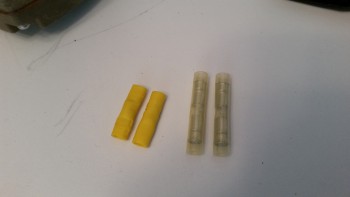
With my repair completed, I hooked up the wiring harness, sans the AEX and with a jumper wire in place between AEX P2 connector pins 5 & 6, and hit the switch.
Ahh, sweet success! The actuator motor came to life and up it went!
With the nose gear actuator back online, I took a quick break to unearth my layups from last night and clean them up. I pulled the peel ply & razor trimmed the edges. Here’s the final results.
So, after some minor cleanup sanding, both BC1s are ready for install as is the draft plate. [Note: since the draft plate is simply just that, a plate to keep the cold air from entering the NG30 nose gear box, I intentionally laid it up dry. I did this by peel plying each side but then adding very little epoxy. Again, since this plate isn’t intended to be structural, this keeps it as light as possible.]
I then grabbed my tube of grease and applied a thin film to the nose wheel bracket stem before reattaching the nose wheel assembly to the NG15 bracket on the end of the gear strut. I reattached the gear strut in place to the NG8 pivot hard points on the NG30s. Finally, I pulled out the NG3 & NG4 brackets and played around with those for a few minutes to get an idea of how they would fit (NG3 is shown on the gear strut & NG4 is sitting on the work table just to the right of NG3).
Lastly, I installed the nose gear actuator into the NG30 nose gear box and wired it all up. I took out my ruler and did a rough measurement of around 6.75″ from the center of the NG6B attach bolt down to the center of the NG4 bracket. I then made a small tick mark on the gear strut at the top edge of the NG4. I clamped the NG4 bracket in place (not shown) and tested the gear going up & down. When I ran the gear up the first time I stopped it just below the F22 channel and then raised it a few bursts at a time. This was to ensure that A) the gear strut fit the F22 channel and cleared the sides, and B) the gear wasn’t going to crush the floor of the fuselage.
I was absolutely pleased that the wheel fit perfectly in the wheel well and that the gear strut stopped just shy of kissing the fuselage floor in the nose gear strut channel. In addition, the front of the wheel (bottom as it sits in the wheel well) was just above the bottom surface of the fuselage by about 0.07″. I had meant to take a pic but apparently I didn’t.
So out of the gate things were looking pretty good spacing-wise with the nose gear. But when I cycled the gear a couple of more times I noticed that everything wasn’t looking as spiffy as it did the first time around. And then I found the culprit. The NG4 bracket had slipped slightly since I apparently hadn’t tightened the clamps down securely enough. No worries, I’ll finalize the gear travel later and then move onto mounting the NG3/NG4 to the gear strut.
Although the gear troubleshooting was a real PITA, in hindsight I’m glad it all happened. Besides upgrading a critical failure point (apparently), I learned an immeasurable amount of information about my nose gear actuator system wiring. Instead of just barely getting through the wiring to get it to work and then moving on to the next task at hand (to be clear: I’m speaking about me here, and in no way mean this to slight other builders!), I feel like I have a really good solid working knowledge of the nose gear actuator wiring now.
The next steps will include widening the F22 gear strut channel on the right side very slightly and then getting the gear up/down travel dialed in. Once the gear travel is good, I’ll be permanently mounting the NG3/NG4 brackets to the nose gear strut.
